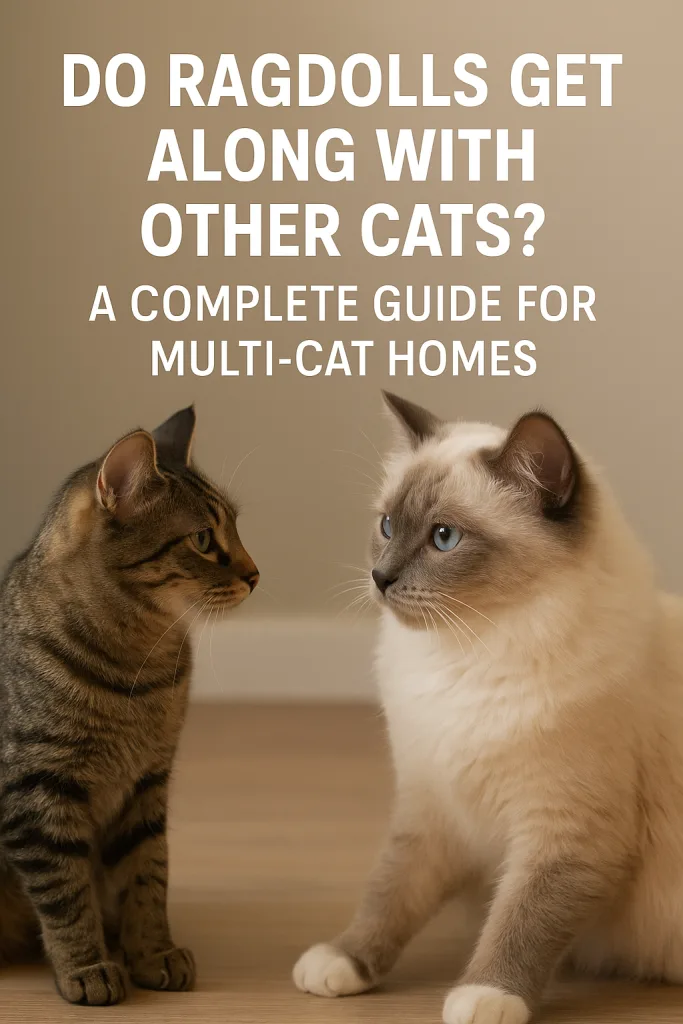Ragdoll cats are known for their calm, friendly, and affectionate nature. Because of their gentle personality, many cat parents wonder whether Ragdolls can comfortably live in multi-cat households. The good news? In most cases, yes Ragdolls get along very well with other cats, but their success depends on several important factors.
Below is a complete, expert-verified guide to help you understand how Ragdolls behave around other cats and how to ensure a smooth integration.

Factors That Influence Do Ragdolls Get Along with Other Cats
1. Personality
Every cat is unique. Ragdolls are typically easygoing, but:
- Confident, friendly cats match best with them
- Very dominant or aggressive cats may overwhelm a gentle Ragdoll
- Shy cats may initially struggle with a Ragdoll’s affection-seeking behavior
2. Age
Younger cats often adjust faster.
Older cats may need more time and structured introductions.
3. Socialization History
Cats who previously lived with other pets usually adapt more easily than cats who have always been alone.
4. Environment
Cats need:
- Enough space
- Separate resting areas
- Safe “escape routes”
A peaceful environment encourages positive interactions.

How Long Can Your Ragdoll Cat Be Left Alone?
Ragdolls are more social than many other breeds. They form strong bonds and don’t enjoy long periods of isolation.
A general guideline:
- 4–6 hours is ideal
- Up to 8 hours is manageable with enrichment
- Avoid leaving them alone regularly for 10+ hours
If you’re away often, having another friendly cat can reduce loneliness—but only if they get along well.
How to Introduce a Ragdoll to Another Cat
A slow, positive introduction is the key to long-term harmony.
1. Scent Swapping
Swap bedding or use a cloth to gently rub each cat’s cheeks, then transfer the scent.
2. Safe Room
Keep your new cat in a separate room for the first few days:
- Food
- Water
- Litter box
- Hiding spots
3. Visual Introduction
Use a baby gate, cracked door, or carrier to let them see each other without contact.
4. Controlled Meetings
Increase short, supervised sessions:
- Feed treats
- Play together
- End each session on a positive note
5. Full Integration
Once both cats show relaxed body language, slowly allow more freedom.
Signs Your Ragdoll and Other Cat Are Getting Along
- Mutual grooming – a strong sign of trust
- Playing appropriately – taking turns, no real aggression
- Sleeping near each other – comfort and safety
- Peaceful coexistence – calmly sharing space, resources, and routines
When They Don’t Get Along: What to Do
1. Re-Introduction Strategies
If tension rises:
- Separate the cats
- Start from the scent-swapping step
- Move more slowly than before
2. Resource Expansion
To reduce competition, provide:
- 1 litter box per cat + 1 extra
- Multiple feeding stations
- More scratching posts
- High perches and hiding spots
For treats useful during training or bonding:
👉 Best Cat Treats for Picky Eaters
3. When to Consult a Feline Behaviorist
A behavior expert can help if:
- One cat is bullying or blocking resources
- There’s persistent aggression
- Tension continues after several weeks of re-introductions
Conclusion
Ragdolls are generally excellent companions for multi-cat homes due to their sweet and sociable nature. However, success depends on:
- Matching personalities
- Providing enough space and resources
- Using proper introduction techniques
With patience and the right setup, most Ragdolls can thrive alongside other cats and become loving, peaceful members of your feline family.
FAQ
Do Ragdoll cats get jealous of other cats?
Yes, Ragdolls can feel jealous if they don’t receive enough attention. They bond strongly with their owners, so giving equal affection to all pets helps prevent jealousy.
Which cat has the highest IQ?
Breeds known for high intelligence include the Abyssinian, Siamese, Bengal, and Savannah. Individual intelligence varies, but these breeds are often ranked as the quickest learners.
Vet-Verified Outbound Resources
These high-authority, pet-safe sites support the guidance above:
- Cornell Feline Health Center — https://www.vet.cornell.edu
- International Cat Care — https://icatcare.org
- American Association of Feline Practitioners — https://catvets.com
